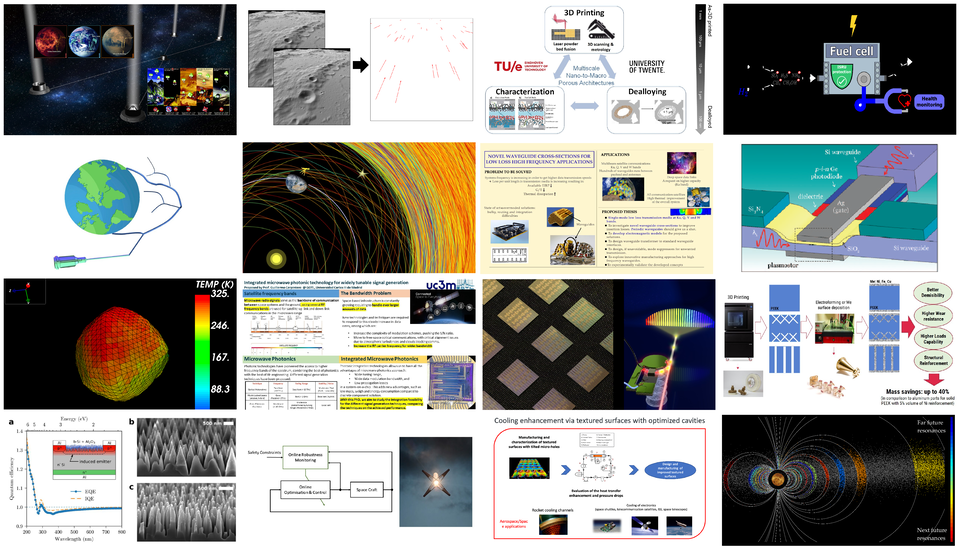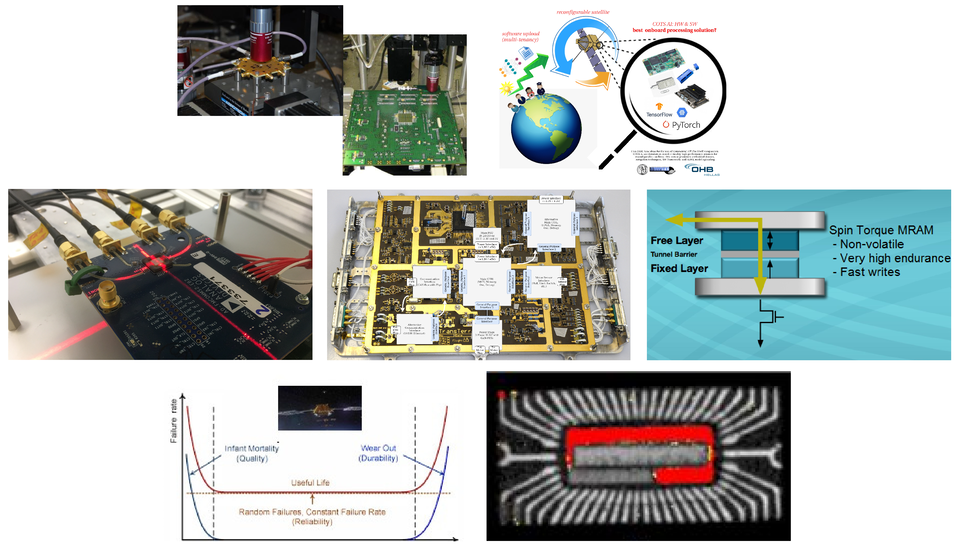Implemented OSIP ideas — July 2021
ESA's Open Space Innovation Platform (OSIP) seeks novel ideas for new space research activities. Campaigns and Channels invite solutions to specific problems or ideas on more general topics, with those run by Discovery & Preparation, including the Open Discovery Ideas Channel, specifically looking for ideas that could be implemented as system studies, early technology developments, or PhD or postdoc research co-funded by ESA and a university.
Open Discovery Ideas Channel

In July 2021, the following ideas were implemented through the Open Discovery Ideas Channel.
--------------------------------------------------
Robust trajectory design techniques accounting for generic evolving uncertainties
Politecnico di Milano
Even though computers have become much more powerful in recent years, some parts of planning a space mission remain computationally inefficient. This includes analyses such as calculating trajectories, predicting spacecraft atmospheric re-entries and choosing planetary fly-bys. These analyses are affected by uncertainties which are a bottleneck for the trajectory design. This co-funded research project aims to tailor computational resources for reliable trajectory design and orbit propagation.
--------------------------------------------------
Development of PEEK-metal reinforced mechanical components for space applications
Astronika
A hard and electrically conductive plastic called PEEK is an interesting option for future space applications. This early technology development project will combine two manufacturing techniques – 3D printing and electroforming – to produce PEEK/metal reinforced composite. Spacecraft parts made of this composite material will have better mechanical properties than those made of PEEK alone. It will also be easier to make parts with a complex shape compared to metal alone.
--------------------------------------------------
Nano-black coating on silicon CMOS image sensors for extreme sensitivity
The Open University
Very sensitive image sensors are particularly important for low-light imaging, such as when observing distant astronomical objects or Earth at night, or for high-speed imaging. Anti-reflection coatings are already used to increase sensors' sensitivity. This study aims to manufacture image sensors with a promising novel anti-reflection coating made of nanostructured black silicon. The study will characterise the performance of these sensors. If successful, the project will substantially improve the performance of future silicon detectors for space and other applications.
--------------------------------------------------
Occultation astrometry for NEA study and risk mitigation
CNRS
Read about this public idea in OSIP
--------------------------------------------------
Environment resilient plants for space exploration
Algentech
The future of space exploration depends on our ability to grow plants in space. Plants could provide food, water and even medicine. However, soil at the surfaces of the Moon, Mars and other planets contains toxic compounds, and most plants would struggle with the high levels of radiation, low temperatures, low light levels and lack of oxygen. This early technology development project aims to engineer plants that can tolerate specific toxic compounds and ionising radiation.
--------------------------------------------------
Toward next generation 3D printed materials for space applications: hierarchical nano-porous structures with engineered macro-architectures
University of Twente
Large-scale and high-energy systems required for space and aviation in the future will require large stores of energy. Existing batteries will not be good enough. 3D printing is a promising solution to make materials that can store enough energy compared to their mass. This early technology development project will combine 3D printing with a technique called electrochemical dealloying to develop a new type of porous metal that could be ideal for various energy applications.
--------------------------------------------------
Novel waveguide cross-sections for low loss high frequency applications
Universidad Politécnica de Madrid
Communication satellites link different parts of Earth and play a vital role in the global telecommunications system. Satellites share information at a specific frequency band (just like radio stations use a specific frequency). Working frequencies are currently increasing to enable more data to be transmitted more quickly. But increasing the frequency increases signal loss in the transmission media. The aim of this co-funded research project is to design, manufacture and then validate transmission media in which losses are lower than in current transmission media.
--------------------------------------------------
Next generation thermophysical modelling of asteroids, and first application to Didymos, target of the HERA mission
Royal Observatory of Belgium
Read about this public idea in OSIP
--------------------------------------------------
Machine learning-driven design requirements for future ESA exo-life finder observatories
ETH Zürich
What is life? How unique is it to our planet? How common is it in the Universe? Only by looking out into space will we be able to answer these questions. But how do we optimise our telescopes to find life on planets outside the Solar System? This co-funded research project will carry out the first ever comprehensive study of the newest machine learning methods for characterising rocky, potentially habitable planters. It will link the results of the study with a new instrument and survey simulator for ESA's Voyage 2050 LIFE mission concept.
--------------------------------------------------
ISRU proof unitised regenerative fuel cells
Graz University of Technology
Read about this public idea in OSIP
--------------------------------------------------
Integrated piezo-optomechanical nanophotonic device
Swiss Federal Institute of Technology Lausanne (EPFL)
Read about this public idea in OSIP
--------------------------------------------------
Integrated microwave photonic technology for wide-frequency tuning signal generation
University Carlos III of Madrid
'Microwave photonics' is a field combining the best of photonic and radiofrequency engineering to generate, transmit and process signals with frequencies of 3–300 GHz. This co-funded research project aims to use microwave photonics technology to improve the quality of signals generated in this frequency range.
--------------------------------------------------
In space demonstration of 3D bio-printed vascularisation techniques
Université Libre de Bruxelles
Read about this public idea in OSIP
--------------------------------------------------
Global autonomous navigation system for planetary approach and landing
DLR
An autonomous spacecraft has the capability to make its own decisions, without any support from humans on Earth. It is useful for a variety of applications, including precise and safe landings on the Moon and other planets. This co-funded research project aims to develop and test a system for a spacecraft to carry out fully autonomous precise navigation around planetary bodies. This would enable new missions to be planned, such as exploring a planet with a swarm of spacecraft, or precise landing on very distant objects.
--------------------------------------------------
Plasmostor digital twin technology and its impact to mitigate space radiation
Istituto Italiano di Technologia
Spacecraft are exposed to high levels of radiation from the Sun and other cosmic sources. This can cause a wide variety of issues, from temporary data corruption to permanent damage. This co-funded research project will create a 'digital twin' of a plasmoster (plasmonics metal oxide semiconductor transistor – transistors are one of the basic building blocks of modern electronics). The researchers will digitally test a range of scenarios on the plasmoster, including orbiting close to Earth, travelling near to the Sun, and landing on the Moon or Mars.
--------------------------------------------------
Cooling enhancement via textured surfaces with optimised cavities
KU Leuven
Spacecraft need to be able to cool themselves down for a number of reasons – they need a cooling channel for the engine thrust chamber, heat exchangers for CCD cameras on temperature-sensitive telescopes and a way to cool electronic units in telecommunication systems. Cooling techniques have existed for decades, but they need to be improved. This co-funded research project aims to investigate how textured surfaces can impact the cooling capabilities of spacecraft.
--------------------------------------------------
Analytical online V&V tools for uncertain nonlinear systems under safety constraints over finite time and control horizons
Technische Universität Dresden
Future space missions will become more challenging, for example because reusable launchers are becoming more popular, crewed missions to the Moon and Mars are on the cards, and more elaborate automated robotic missions around Earth are planned. Because these missions are more complex and need to be more autonomous, existing methods for planning, guidance and control systems will no longer be enough to ensure their safety and success. This co-funded research project will explore how to improve the performance and reliability of autonomous space systems with specific uncertainty and safety constraints using analytical online robust performance and stability monitoring.
--------------------------------------------------
Commercial off-the-shelf (COTS) components

The following ideas were implemented through the Campaign for new ideas for the use of Commercial Off The Shelf (COTS) components.
--------------------------------------------------
MOSFET commercial plastic components survey and its SEE characterisation
Alter Technology
Read about this public idea in OSIP
--------------------------------------------------
Investigations on wideband radio frequency agile transceivers under radiation conditions
DLR
Read about this public idea in OSIP
--------------------------------------------------
Intelligent COTS based power stages for robotic applications
DFKI
Modern computers demonstrate how useful modular designs can be; the assembly and exchange of components such as a CPU, GPU, power supply and storage media is relatively simple. In space, the recent rise in CubeSat projects has also shown the advantages of modularity and COTS parts to reduce development costs. In a step towards using these concepts in a broader range of space applications, this early technology development project aims to demonstrate a modular power stage of a robotic actuator made up of several printed circuit boards that use COTS components.
--------------------------------------------------
Evaluation of spin-transfer torque DDR MRAM in space environment
Thales Alenia Space
Within a spacecraft's electronic 'brain' is a place to store memory. This early technology project aims to test how two COTS MRAM systems respond to radiation. MRAM is a type of random-access memory (RAM) that stores data in magnetic domains, rather than as an electric charge or current flow. It is an interesting alternative to existing memory systems, for example because it could store more data and withstand higher levels of radiation.
--------------------------------------------------
Delaminations in plastic package: evolution under constraints
Thales Alenia Space
Read about this public idea in OSIP
--------------------------------------------------
COTS wear out test – for 15 years in space use
Thales Alenia Space
Based on a commonly used reference, this early technology development project aims to answer to the question 'What is the real life duration for an electrical COTS part?' by performing life tests in different conditions for up to 6500 hours. Following these tests, the researchers will estimate the 'space lifetime duration' for various circuits and components.
--------------------------------------------------
COTS AI accelerators in mixed-criticality high performance avionics for reconfigurable satellites
DLR
Today’s satellites tend to be inflexible and purpose-built for a single mission. The space community is starting to explore disruptive approaches to repurpose satellites in orbit and process data on board. One of the most promising ways to do so is to use COTS parts. Following the success of artificial intelligence (AI) and machine learning on Earth, it would be interesting to see how AI-oriented hardware can facilitate deep learning and pre-process sensor data in orbit. This study will explore the benefits of using COTS AI accelerators; these devices are designed to perform artificial intelligence functions more efficiently compared to software running on a general-purpose central processing unit.
--------------------------------------------------
Adoption of SEE laser testing as part of the RHA process for COTS screening and validation
Airbus Defence and Space
Read about this public idea in OSIP
--------------------------------------------------
Model-Based System Engineering (MBSE)
The following idea was implemented through the OSIP Model-Based System Engineering Campaign.
--------------------------------------------------
A distributed ledger approach to MBSE
University of Strathclyde
Space systems are becoming ever more complex to manage via traditional methods. Model-based system engineering (MBSE) ensures digital continuity throughout a mission’s life cycle, across disciplines and throughout supply chains. Like the transition from analogue to digital, the transition from documentation to models will enable space projects to be much more efficient. This study will address two key MBSE needs: an automated mechanism to control data exchange, and to maintain traceability across the system development and operations lifecycle. Distributed Ledger Technologies (of which blockchain is an example) can provide a model for data governance, distribution and integrity for system model datasets.
--------------------------------------------------















 Germany
Germany
 Austria
Austria
 Belgium
Belgium
 Denmark
Denmark
 Spain
Spain
 Estonia
Estonia
 Finland
Finland
 France
France
 Greece
Greece
 Hungary
Hungary
 Ireland
Ireland
 Italy
Italy
 Luxembourg
Luxembourg
 Norway
Norway
 The Netherlands
The Netherlands
 Poland
Poland
 Portugal
Portugal
 Czechia
Czechia
 Romania
Romania
 United Kingdom
United Kingdom
 Slovenia
Slovenia
 Sweden
Sweden
 Switzerland
Switzerland
























